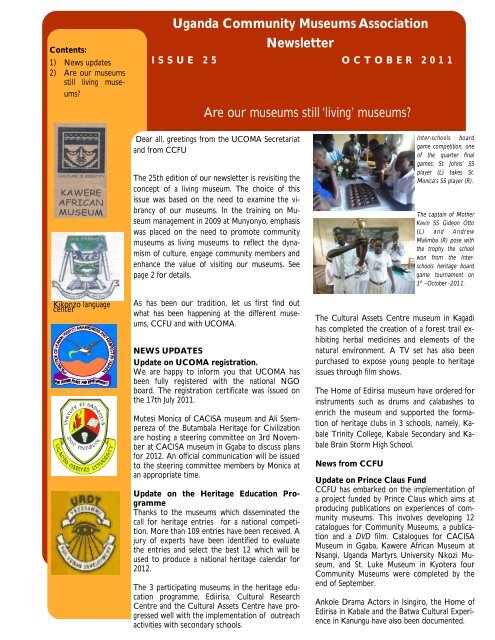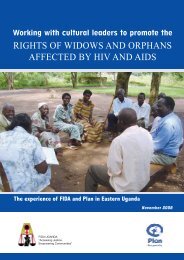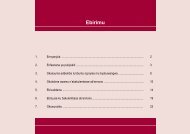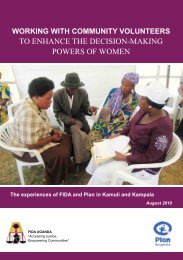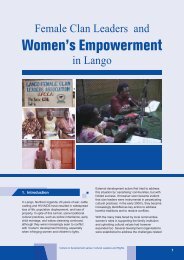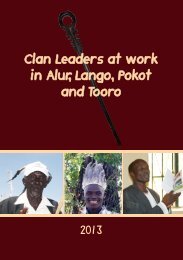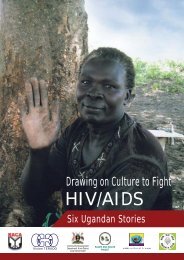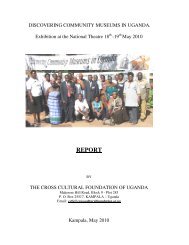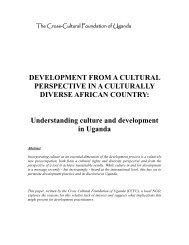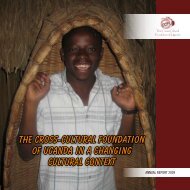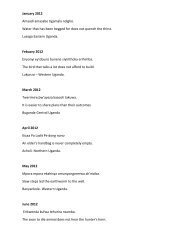October, 2011 - Cross-Cultural Foundation of Uganda(CCFU)
October, 2011 - Cross-Cultural Foundation of Uganda(CCFU)
October, 2011 - Cross-Cultural Foundation of Uganda(CCFU)
You also want an ePaper? Increase the reach of your titles
YUMPU automatically turns print PDFs into web optimized ePapers that Google loves.
Contents:<br />
1) News updates<br />
2) Are our museums<br />
still living museums?<br />
<strong>Uganda</strong> Community Museums Association<br />
Newsletter<br />
I S S U E 2 5<br />
O C T O B E R 2 0 1 1<br />
Are our museums still ‘living’ museums?<br />
Kikonzo language<br />
center<br />
Dear all, greetings from the UCOMA Secretariat<br />
and from <strong>CCFU</strong><br />
The 25th edition <strong>of</strong> our newsletter is revisiting the<br />
concept <strong>of</strong> a living museum. The choice <strong>of</strong> this<br />
issue was based on the need to examine the vibrancy<br />
<strong>of</strong> our museums. In the training on Museum<br />
management in 2009 at Munyonyo, emphasis<br />
was placed on the need to promote community<br />
museums as living museums to reflect the dynamism<br />
<strong>of</strong> culture, engage community members and<br />
enhance the value <strong>of</strong> visiting our museums. See<br />
page 2 for details.<br />
As has been our tradition, let us first find out<br />
what has been happening at the different museums,<br />
<strong>CCFU</strong> and with UCOMA.<br />
NEWS UPDATES<br />
Update on UCOMA registration.<br />
We are happy to inform you that UCOMA has<br />
been fully registered with the national NGO<br />
board. The registration certificate was issued on<br />
the 17th July <strong>2011</strong>.<br />
Mutesi Monica <strong>of</strong> CACISA museum and Ali Ssempereza<br />
<strong>of</strong> the Butambala Heritage for Civilization<br />
are hosting a steering committee on 3rd November<br />
at CACISA museum in Ggaba to discuss plans<br />
for 2012. An <strong>of</strong>ficial communication will be issued<br />
to the steering committee members by Monica at<br />
an appropriate time.<br />
Update on the Heritage Education Programme<br />
Thanks to the museums which disseminated the<br />
call for heritage entries for a national competition.<br />
More than 109 entries have been received. A<br />
jury <strong>of</strong> experts have been identified to evaluate<br />
the entries and select the best 12 which will be<br />
used to produce a national heritage calendar for<br />
2012.<br />
The 3 participating museums in the heritage education<br />
programme, Ediirisa, <strong>Cultural</strong> Research<br />
Centre and the <strong>Cultural</strong> Assets Centre have progressed<br />
well with the implementation <strong>of</strong> outreach<br />
activities with secondary schools.<br />
Inter-schools board<br />
game competition, one<br />
<strong>of</strong> the quarter final<br />
games; St. Johns’ SS<br />
player (L) takes St.<br />
Monica’s SS player (R).<br />
The captain <strong>of</strong> Mother<br />
Kevin SS Gideon Otto<br />
(L) and Andrew<br />
Malimba (R) pose with<br />
the trophy the school<br />
won from the Interschools<br />
heritage board<br />
game tournament on<br />
1 st –<strong>October</strong> -<strong>2011</strong>.<br />
The <strong>Cultural</strong> Assets Centre museum in Kagadi<br />
has completed the creation <strong>of</strong> a forest trail exhibiting<br />
herbal medicines and elements <strong>of</strong> the<br />
natural environment. A TV set has also been<br />
purchased to expose young people to heritage<br />
issues through film shows.<br />
The Home <strong>of</strong> Edirisa museum have ordered for<br />
instruments such as drums and calabashes to<br />
enrich the museum and supported the formation<br />
<strong>of</strong> heritage clubs in 3 schools, namely, Kabale<br />
Trinity College, Kabale Secondary and Kabale<br />
Brain Storm High School.<br />
News from <strong>CCFU</strong><br />
Update on Prince Claus Fund<br />
<strong>CCFU</strong> has embarked on the implementation <strong>of</strong><br />
a project funded by Prince Claus which aims at<br />
producing publications on experiences <strong>of</strong> community<br />
museums. This involves developing 12<br />
catalogues for Community Museums, a publication<br />
and a DVD film. Catalogues for CACISA<br />
Museum in Ggaba, Kawere African Museum at<br />
Nsangi, <strong>Uganda</strong> Martyrs University Nkozi Museum,<br />
and St. Luke Museum in Kyotera four<br />
Community Museums were completed by the<br />
end <strong>of</strong> September.<br />
Ankole Drama Actors in Isingiro, the Home <strong>of</strong><br />
Edirisa in Kabale and the Batwa <strong>Cultural</strong> Experience<br />
in Kanungu have also been documented.
I S S U E 2 5<br />
O C T O B E R 2 0 1 1<br />
Kabalega<br />
Development Founda-<br />
Community Museums in the media:<br />
On the 27th September which was a World<br />
Tourism Day, the New Vision published an article<br />
written by Nsibambi Fredrick calling upon<br />
government to support Community Museums<br />
as one <strong>of</strong> the ways to boost local tourism. In<br />
the article the role and potential <strong>of</strong> community<br />
museums in the area <strong>of</strong> research, education,<br />
tourism was emphasized.<br />
ARE OUR MUSEUMS STILL LIVING<br />
MUSUEMS?<br />
During the training on managing Community<br />
Museums in 2009, Dr. Kamuhangire explained<br />
that a living museum constantly generates new<br />
ideas to bring to its artefacts and stories to life.<br />
A visit to a museum then leaves a lasting impression<br />
and is an experience that is remembered<br />
and shared. This concept is in contrast to<br />
the more conventional museums that tend to<br />
be static, <strong>of</strong>ten irrelevant to the local population’s<br />
learning and information needs, sometimes<br />
depict African culture as backward.<br />
Examples <strong>of</strong> how to make Community Museums<br />
“living” included making video recordings <strong>of</strong><br />
donors as they explain why they donate objects;<br />
linking collections to live dance and drama performances,<br />
linking the museum to local radio<br />
programmes; having annual cultural exhibitions;<br />
linking the collection to contemporary events<br />
and development challenges, such as peace<br />
building; partnering with government and other<br />
institutions such as <strong>Uganda</strong> Wildlife Authority.<br />
Let us reflect on how much we have done to<br />
make our museums lively and relevant to community<br />
needs. If members <strong>of</strong> the community do<br />
not feel that the museums are part <strong>of</strong> them or<br />
at least represent their values, they will not support<br />
them.<br />
But what is a “living museum?”<br />
It is a museum that recreates to the fullest extent<br />
conditions <strong>of</strong> a culture, natural environment or<br />
historical period and connect with members <strong>of</strong><br />
the community. Sometimes, a drama performing<br />
group <strong>of</strong> historical re-enactment <strong>of</strong> historical<br />
scenes in historical buildings is considered as a<br />
living museum.<br />
Living museums present an accurate portrayal <strong>of</strong><br />
what life was like in a certain time period with the<br />
use <strong>of</strong> live acting, in addition to books and photographs.<br />
These museums provide a more active,<br />
hands-on learning environment.<br />
This mind map was developed during the 2009<br />
training in Munyonyo. It presents ideas on what is<br />
considered to be a living museum.<br />
Signs <strong>of</strong> a museum that is not living?<br />
These may include:<br />
1. A museum that is not open to the public especially<br />
to members <strong>of</strong> the neighbouring communities<br />
2. Lack <strong>of</strong> access to museum objects in case<br />
they are all in store or are glass cased with<br />
‘do not touch’ labels<br />
3. Absence <strong>of</strong> social-cultural events to engage<br />
community members<br />
4. Weak link with the evolving value and significance<br />
attached to artefacts<br />
5. Limited demonstrations and opportunities to<br />
transfer skills and knowledge to members <strong>of</strong><br />
the community
P A G E 2<br />
U G A N D A C O M M U N I T Y M U S E U M S A S S O C I A T I O N N E W S L E T T E R<br />
The home <strong>of</strong> Edirsa<br />
Buganda Museum<br />
-<br />
Butambala Heritage<br />
Center for Civilization<br />
-Karamoja Women <strong>Cultural</strong><br />
Group-Karamoja<br />
-Ankore<br />
Isingiro<br />
Dramactors-<br />
-Attitude change museum<br />
-Bulemba Museums in<br />
Rwenzori Mountains<br />
-C.N. Kikonyogo Money<br />
Museum<br />
5. Lack <strong>of</strong> appropriate programmes for different<br />
categories <strong>of</strong> community members for instance,<br />
young people, tourists and elderly people<br />
6. Lack <strong>of</strong> creativity in a museum where one object<br />
is showcased to the public for a long period<br />
7. Lack <strong>of</strong> new collections<br />
Some examples <strong>of</strong> living museums<br />
1. The Home <strong>of</strong> Edirisa museum: it engages<br />
with community members including young<br />
people<br />
2. Igongo <strong>Cultural</strong> Museum: it also engages<br />
community members <strong>of</strong> all age groups with<br />
different events.<br />
3. <strong>Cultural</strong> Research Centre Museum: It engages<br />
young people from schools as well<br />
researchers from tertiary institutions.<br />
4. <strong>Cultural</strong> Assets Centre: It engages members<br />
<strong>of</strong> the community with different activities<br />
including radio programmes on the cultural<br />
heritage <strong>of</strong> Bunyoro.<br />
5. Batwa <strong>Cultural</strong> Experiences: This museum<br />
allows the Batwa people to recreate their<br />
traditional lifestyles and showcase them to<br />
other members <strong>of</strong> the community including<br />
tourists.<br />
What can we do to maintain the lively nature<br />
<strong>of</strong> our museums and to ‘resurrect’<br />
those that are on a ‘deathbed’?<br />
1. Organize social-cultural events at our museums<br />
not only as a way <strong>of</strong> publicizing our museums<br />
but also as a way <strong>of</strong> engaging with<br />
community members.<br />
2. Encourage community participation. This can<br />
take the form <strong>of</strong> involvement as a volunteers.<br />
For example, encouraging community<br />
members to collect objects and preserve<br />
them in your museum. This further connects<br />
community members to the museum if the<br />
objects are attributed to them.<br />
3. Organize exciting activities to engage young<br />
and old people such as board game competitions.<br />
4. Encourage members <strong>of</strong> the community to<br />
form “friends <strong>of</strong> the museum” associations.<br />
Through this kind <strong>of</strong> associations members<br />
can boost visitation to the museum as well<br />
as enhancing the appreciation and understanding<br />
<strong>of</strong> cultural heritage objects preserved<br />
inside the museum.<br />
5. Develop simple publicity materials such as<br />
fliers giving information about your museum<br />
activities for different age groups. The fliers<br />
can be distributed in places like bus/taxi<br />
parks, super markets, restaurants and<br />
schools among other places.<br />
6. Provide opportunities for community members<br />
to exhibit and transfer their knowledge<br />
and skills e.g. during a Museum Open<br />
day or a <strong>Cultural</strong> Quiz<br />
7. Take the museum to the community. Organize<br />
mini-exhibitions during public gatherings<br />
or trade shows or community markets.<br />
Ankole <strong>Cultural</strong> Drama Actors museum<br />
and <strong>Cultural</strong> Research Centre Jinja, have<br />
done this before quite successfully for the<br />
public and schools, respectively. Find out<br />
how they did it—Call CRC on 0772844221<br />
and Ankole Museum on 0776121945 now!<br />
Why do we need living museums?<br />
Because the younger generations are the custodians<br />
<strong>of</strong> our cultural heritage and this is one<br />
important way to capture and retain their interest<br />
in their heritage.<br />
In <strong>Uganda</strong>, Community Museums are not well<br />
known but have the advantage <strong>of</strong> being closer<br />
to the people and have the potential <strong>of</strong> restoring<br />
the appreciation <strong>of</strong> heritage. But they are<br />
also faced with stiff competition from other<br />
attractions such as computer games, movies,<br />
television, etc.<br />
We hope the information in this edition will<br />
help to make a difference in our museums and<br />
in how we engage with members <strong>of</strong> the community.<br />
From the editors we wish you all the best!<br />
Nsibambi<br />
Fredrick<br />
(<strong>CCFU</strong>)<br />
Mutesi Monica<br />
(CACISA)<br />
Oloka Fred (CRC)<br />
P E O P L E ’ S M U S E U M N E W S L E T T E R


